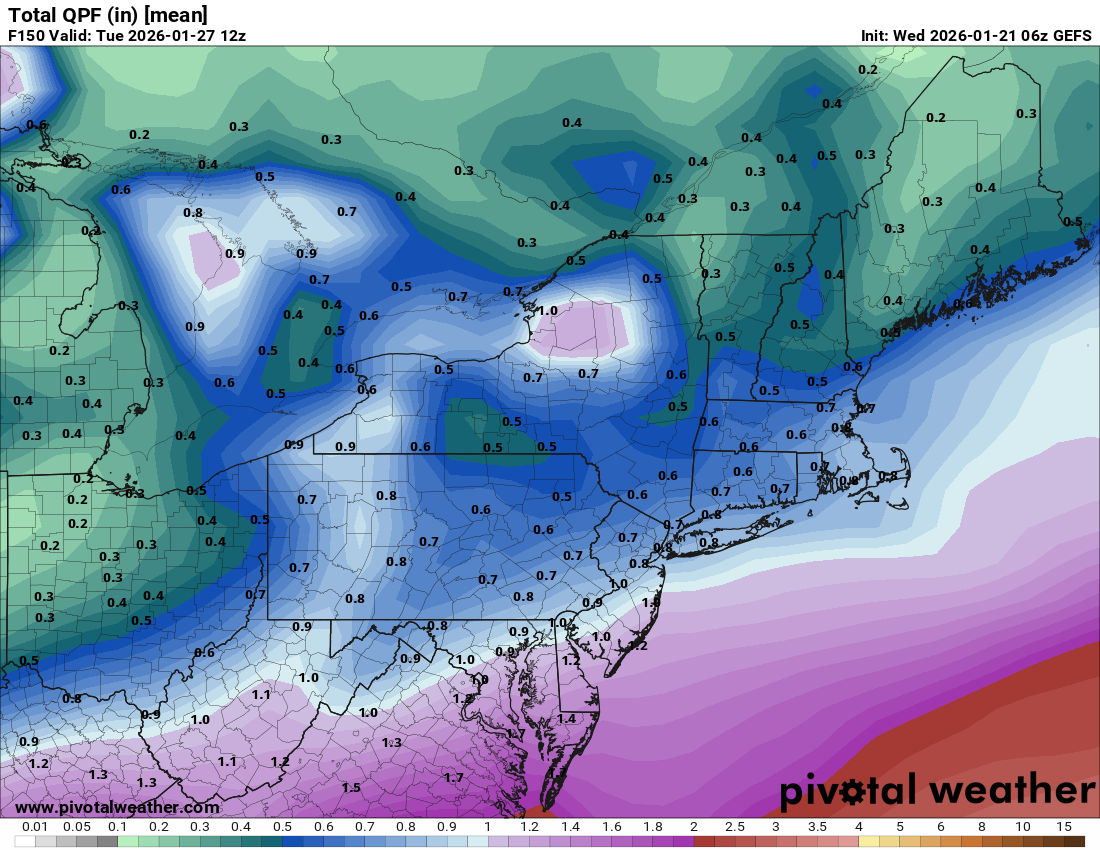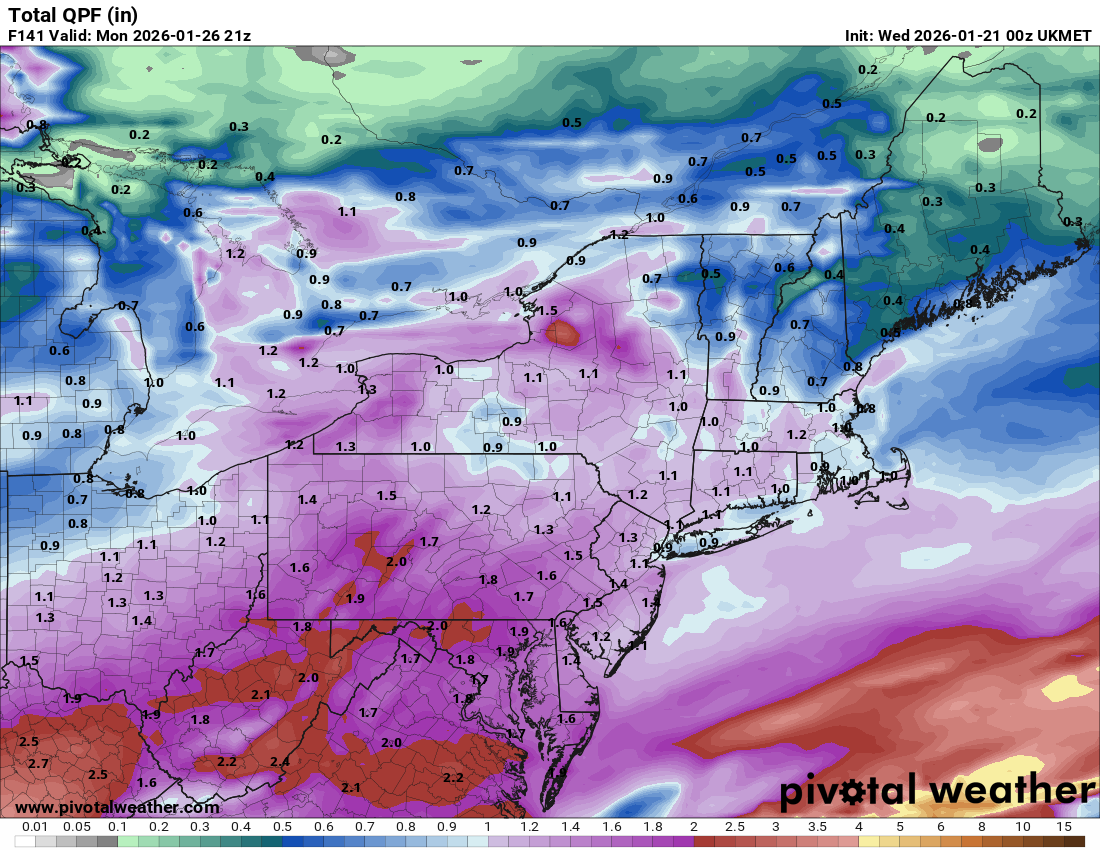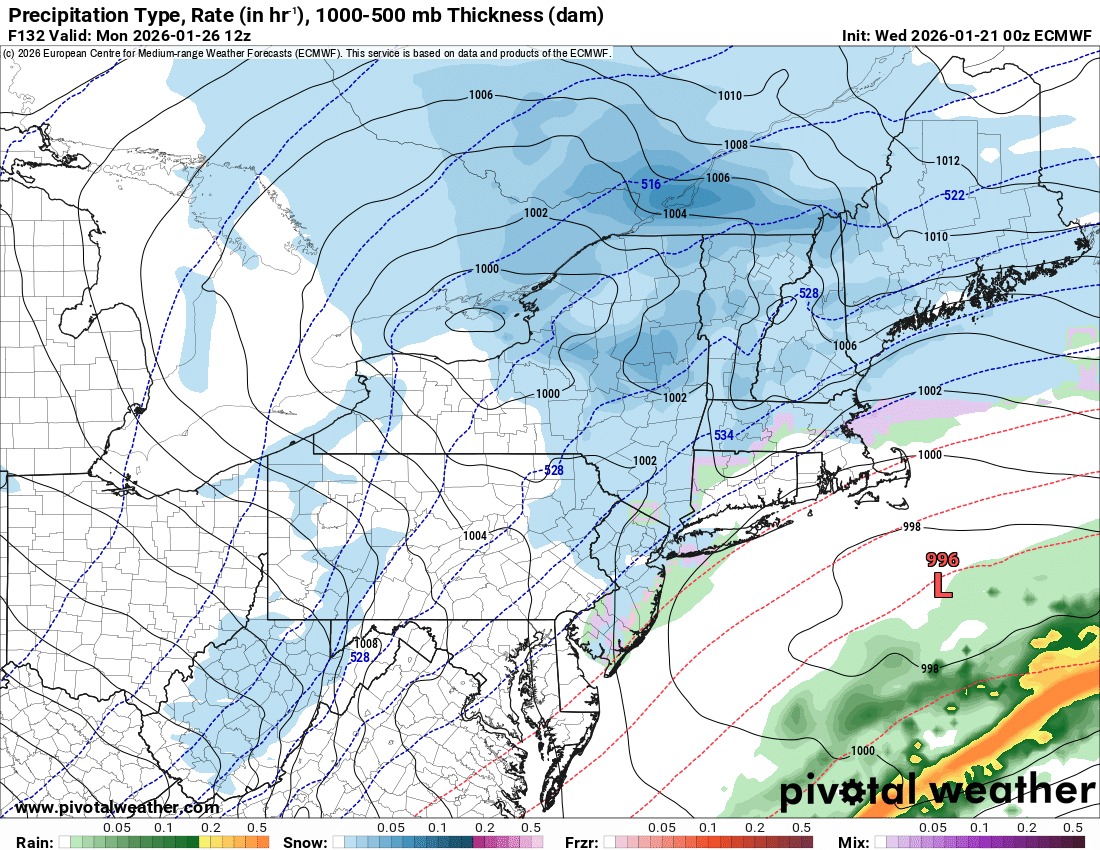
SACRUS
-
Posts
14,339 -
Joined
-
Last visited
Content Type
Profiles
Blogs
Forums
American Weather
Media Demo
Store
Gallery
Posts posted by SACRUS
-
-
14 / 3 off a low of 1 here. A brief warmup Thu / Fri ahead of the next arctic airmass (coldest of the season) arriving in phases first Sat with the much tracked storm Sun - Tue then reinforcing arctic air next week 1/28 - 1/30. Cold into the end of the month, moderation towards the 2/2 period. Overall cold otherwise strongest cold over the next 10 days with 1 or 2 potential storms to dump some snow in between.
-
06Z GEFS Total QPF storm mean
-
1/21 06Z Total QPF - Storm
ICON: 0.8 (120H)
GFS: 1.0 - 1.2
GFS AI AIGFS: 0.8
EURO: 1.2
EURO AI AIFS: 1.1
GEFS: 0.8-
 1
1
-
-
06z EuroAI AIFS Total QPF - Storm

-
06Z GFS AI AIGFS Total QPF:

-
1/21 6Z Total QPF (Storm)
GFS:
-
North with the 1 inch line
-
2 hours ago, SACRUS said:
1/21 00Z Total QPF
ICON: 0.9 - 1.0 (12z hold)
GGEM: 1.0 - 1.1 (12z increase slight)
GFS: 0.9 - 1.0 (12Z increase)
GFS AIFS: 0.7 - 0.8 (12z increase)
UKMET: 0.9 - 1.1 (12z Hold)
GEFS: 0.7 - 0.8 (12z / 18z increase)
Euro: 1.1 (12Z Increase)
Euro AI AIFS: 0.8
Updated all models with at least a solid hit -
00Z Euro Total Storm QPF

-
-
-
-
2 hours ago, SACRUS said:
1/21 00Z Total QPF
ICON: 0.9 - 1.0 (12z hold)
GGEM: 1.0 - 1.1 (12z increase slight)
GFS: 0.9 - 1.0 (12Z increase)
GFS AIFS: 0.7 - 0.8 (12z increase)
UKMET: 0.9 - 1.1 (12z Hold)
GEFS: 0.7 - 0.8 (12z / 18z increase)
Euro AI AIFS: 0.8
Updated -
-
1 hour ago, SACRUS said:
1/21 00Z Total QPF
ICON: 0.9 - 1.0 (12z hold)
GGEM: 1.0 - 1.1 (12z increase slight)
GFS: 0.9 - 1.0 (12Z increase)
GFS AIFS: 0.7 - 0.8 (12z increase)
UKMET: 0.9 - 1.1 (12z Hold)
GEFS: 0.7 - 0.8 (12z / 18z increase)
Updated-
 1
1
-
-
GEFS 00Z QPF Total mean
-
 1
1
-
-
UKMET 00Z
Total QPF

-
56 minutes ago, SACRUS said:
1/21 00Z Total QPF
ICON: 0.9 - 1.0 (12z hold)
GGEM: 1.0 - 1.1 (12z increase slight)
GFS: 0.9 - 1.0 (12Z increase)
GFS AIFS: 0.7 - 0.8 (12z increase)Updated
-
1/21 00Z GGEM B Total QPF

-
-
43 minutes ago, SACRUS said:
1/21 00Z Total QPF
ICON: 0.9 - 1.0 (12z hold)
GGEM:
GFS: 0.9 - 1.0 (12Z increase)
GFS AIFS: 0.7 - 0.8 (12z increase)
Updated-
 1
1
-
-
-
GFS:
Total QPF Storm
-
1/21 00Z Total QPF
ICON: 0.9 - 1.0 (12z hold)
GGEM: 1.0 - 1.1 (12z increase slight)
GFS: 0.9 - 1.0 (12Z increase)
GFS AIFS: 0.7 - 0.8 (12z increase)
UKMET: 0.9 - 1.1 (12z Hold)
GEFS: 0.7 - 0.8 (12z / 18z increase)
Euro: 1.1 (12Z Increase)
Euro AI AIFS: 0.8-
 1
1
-













January 2026 OBS and Discussion
in New York City Metro
Posted
Records:
Highs:
EWR: 62 (2006)
NYC: 63 (2006)
LGA: 64 (2006)
JKF: 61 (2006)
Lows:
EWR: -8 (1985)
NYC: -2 (1985)
LGA: -3 (1985)
JFK: -2 (1985)
Historical:
1854: This was the coldest day of the famous California cold winter when Sacramento, CA dropped to 19°. (Ref. Wilson Wx. History)
1863 - A severe coastal storm dropped heavy rain on the Fredericksburg area of Virginia. It disrupted a Union Army offensive in an ill famed "mud march." (David Ludlum)
1863: The total rainfall in Washington on the 20th-22nd was 3.20 inches (p.39 Washington Weather Book 2002 by Ambrose, Henry, Weiss) (David Ludlum, p. 9)
A severe coastal storm dropped heavy rains on the Fredericksburg area. It rained for 30 hours, dropping more than two inches, making mud so deep that mules and horses died attempting to move equipment. The rivers became too high and swift to cross, disrupting the Union Army offensive operation in the ill-famed "Mud March". (Ref. Virginia Wx. History)
1893: Record snows fell across west Texas. Lubbock broke their single storm snowfall record with 16.8 inches. Plainview, TX recorded 18 inches. Dalhart, TX picked up 15 inches of the white stuff. (Ref. Wilson Wx. History)
1918: Temperature rose 83 degrees at Granville, ND over several hours, from a morning reading of -33° to 50° by the afternoon. (Ref. Wilson Wx. History)
1922: High pressure areas that move across this region in the depths of winter are stronger than at any other times of the year. The barometer at Collegeville, MN hit 31.11 inches of mercury. A new record high pressure for MN. (Ref. AccWeather Weather History)
1936: Warroad, MN fell to a bone-chilling 55 °F below zero today. (Ref. AccWeather Weather History)
1959: The maximum temperature for the date in Washington, DC is 70°F.(Washington Weather Records - KDCA)
A winter storm produced 8 to 12 inches of snow across the northern third of Illinois. Further south, a 70 mile wide area, from Jerseyville to Danville, received a half to one inch of ice accumulation. Thousands of homes were without power for several days. This was described as the worst ice storm in Springfield, IL since 1942, and the worst in Champaign, IL in at least 50 years.(Ref. Wilson Wx. History)
1963: Up to 3" of snow falls on San Francisco, their heaviest since 1887.
1979: January 20-21, Up to an inch of solid ice was reported over sections of Southwest Virginia. Numerous trees and power lines came down causing extended power outages. Some localities were still without power a week after the storm. Pittsylvania County reported $1 million in damage to trees. Utility damages were in the millions. Damage also occurred to homes and vehicles from trees falling on them. (Ref. Virginia Wx. History)
1982 - The second of two major snowstorms to hit southern Minnesota came to an end. Minneapolis received 20 inches of snow in 24 hours to break the previous record of 17 inches in 24 hours established just a few days earlier. A record 38 inches of snow covered the ground following the two storms, with drifts ten feet high. (David Ludlum)
1982: Subzero temperatures have occurred 28 times from 1870 to 1933. For 47 years between the year 1935 and 1982 Washington have had no subzero temperatures. In January 1982 some of the coldest nights were: Jan. 11 and 12 both were +2 degrees F
Jan. 17th was the coldest at -5 degrees F. the first subzero temperature in 47 years in Washington. Jan. 21st was -4 degrees F. (Washington Weather Records - KDCA)
The second of two major snowstorms to hit southern Minnesota came to an end. Minneapolis received 20 inches of snow in 24 hours to break the previous record of 17 inches in 24 hours established just a few days earlier. A record 38 inches of snow covered the ground following the two storms, with drifts ten feet high.(David Ludlum) (Ref. Wilson Wx. History)
1985: The minimum temperature for the date is -4°F. in Washington, DC. (Washington Weather Records - KDCA)
Three days of snow squalls at Buffalo NY finally came to an end. The squalls, induced by relatively warm water in Lake Erie, produced 34 inches of snow at the International Airport, with up to 47 inches reported in the suburbs of Buffalo. The New York "blizzard of 85" left many counties disaster areas. (19th - 21st) (Weather Channel) (Storm Data)
NC record low temperature was recorded today on Mt. Mitchell, NC with a reading of -34 °F. SC also set a new state record for the lowest minimum temperature of -19 °F at Caesars Head, SC an unofficial reading of -20 °F was recorded at Long Creek, SC. Maximum 17° minimum -4° wind chill -30 °F President Reagan was sworn in for a second term in the coldest Inauguration Ceremony of record. Cold and wind resulted in wind chill readings as much as 30 degrees below zero. More eastern cold: Jacksonville, FL recorded its all-time record low (7F). Macon, GA had its coldest day ever with 6F. Many counties in New York were declared disaster areas, because of heavy snow.(Sandra and TI Richard Sanders - 1987) (Ref. AccWeather Weather History)
1985 - Three days of snow squalls at Buffalo NY finally came to an end. The squalls, induced by relatively warm water in Lake Erie, produced 34 inches of snow at the International Airport, with up to 47 inches reported in the suburbs of Buffalo. The New York "blizzard of '85" left many counties disaster areas. (19th-21st) (Weather Channel) (Storm Data) President Reagan was sworn in for a second term in the coldest Inauguration Ceremony of record. Cold and wind resulted in wind chill readings as much as 30 degrees below zero. (Sandra and TI Richard Sanders - 1987)
1985: Jacksonville, Florida, recorded its all-time record low of 7 degrees. Macon, Georgia, had its coldest day ever with a temperature of 6 degrees. It was the coldest Inauguration day in history as President Reagan is sworn in for a second term during cold and winds that resulted in wind chill readings of 30 degrees below zero. Because of the bitter cold temperatures, many outdoor Inauguration events were canceled, and President Reagan was sworn in the Capitol Rotunda.
1987 - Low pressure over Minnesota produced high winds in the Northern Plains Region. Winds gusted to 66 mph at Rapid City SD, and reached 70 mph at Belle Fourche SD. (National Weather Summary) (Storm Data)
1988 - High pressure over northern Nevada and low pressure off the coast of southern California combined to produce high winds in the southwestern U.S. Wind gusts in the San Francisco area reached 70 mph at Fremont. (National Weather Summary) (Storm Data)
1989 - Cold and snow prevailed in the northeastern U.S. Up to 13 inches of snow was reported between Woodford and Searsburg in Vermont. Montpelier VT reported a wind chill reading of 42 degrees below zero. (National Weather Summary) (Storm Data)
1990 - Unseasonably warm weather prevailed across the state of Florida. Eight cities reported record high temperatures for the date, including West Palm Beach with a reading of 86 degrees. Rain in southern New England changed to freezing rain, then to sleet, and then to heavy snow during the late morning. Most of Massachusetts was blanketed with 6 to 10 inches of snow. (National Weather Summary) (Storm Data)
1994: Frigid conditions persisted over the Northeast. All-time record lows were established at Harrisburg, PA: -22°, Wilkes-Barre/Scranton, PA: -21°, Williamsport, PA: -20°, Erie, PA: -18° and Allentown, PA: -15°. Livermore Falls, ME and Grafton, NH recorded morning lows of -40°. The morning low in Worcester, MA was below 0° for the 7th day in a row to establish a new record. (Ref. AccWeather Weather History)
1996: Heavy rains and melting snow due to record warmth results in some of worst flooding ever in PA, MD and VA C&O canal wiped out by flooding. (Bob Ryan's 2000 Almanac)
1999: A major tornado outbreak occurred from the southwest into central and northeast Arkansas during the afternoon and evening. In the Little Rock Area, 30 tornadoes tracked across 15 counties. Homes and businesses were damaged or destroyed in Little Rock, Beebe, McRae, and areas farther north and east. Eight deaths resulted from the tornadoes, with 140 to 150 injuries also reported.
2000: A powerful ocean storm off the coast of New England developed an "eye" as the central pressure fell to 954 millibars or 28.16 Inches of mercury. This was the equivalent of a Category 3 hurricane. (Ref. AccWeather Weather History)
2008: Northern Maine: Temperatures drop well below zero Fahrenheit in extreme northern sections of Maine: Van Buren registers -34° F; Presque Isle bottoms at -27° F and Allagash, falls to -26° F. (Ref. Wx.Doctor)
2011: The lowest temperatures recorded in the NWS Duluth county warning area were -46 degrees at both International Falls, MN (ASOS) and Babbitt, MN (CO-OP). The -46 degree low was tied for the 5th lowest on record at International Falls. Temperature records date back to 1897. The record is -55 degrees which was recorded on January 6, 1909.
What's the coldest city in the lower 48 states? That dubious distinction belongs to our friends in International Falls, MN which has a yearly average temperature of 36.4°. Minnesota and North Dakota each had three cities in the top 10, while South Dakota had none. Some cities on the list include: #2: Duluth, MN at 38.2°, #3: Caribou, ME at 38.9°, #6: Fargo, ND at 40.5° and #9: Bismarck, ND at 41.3°. (Ref. International Falls, MN)